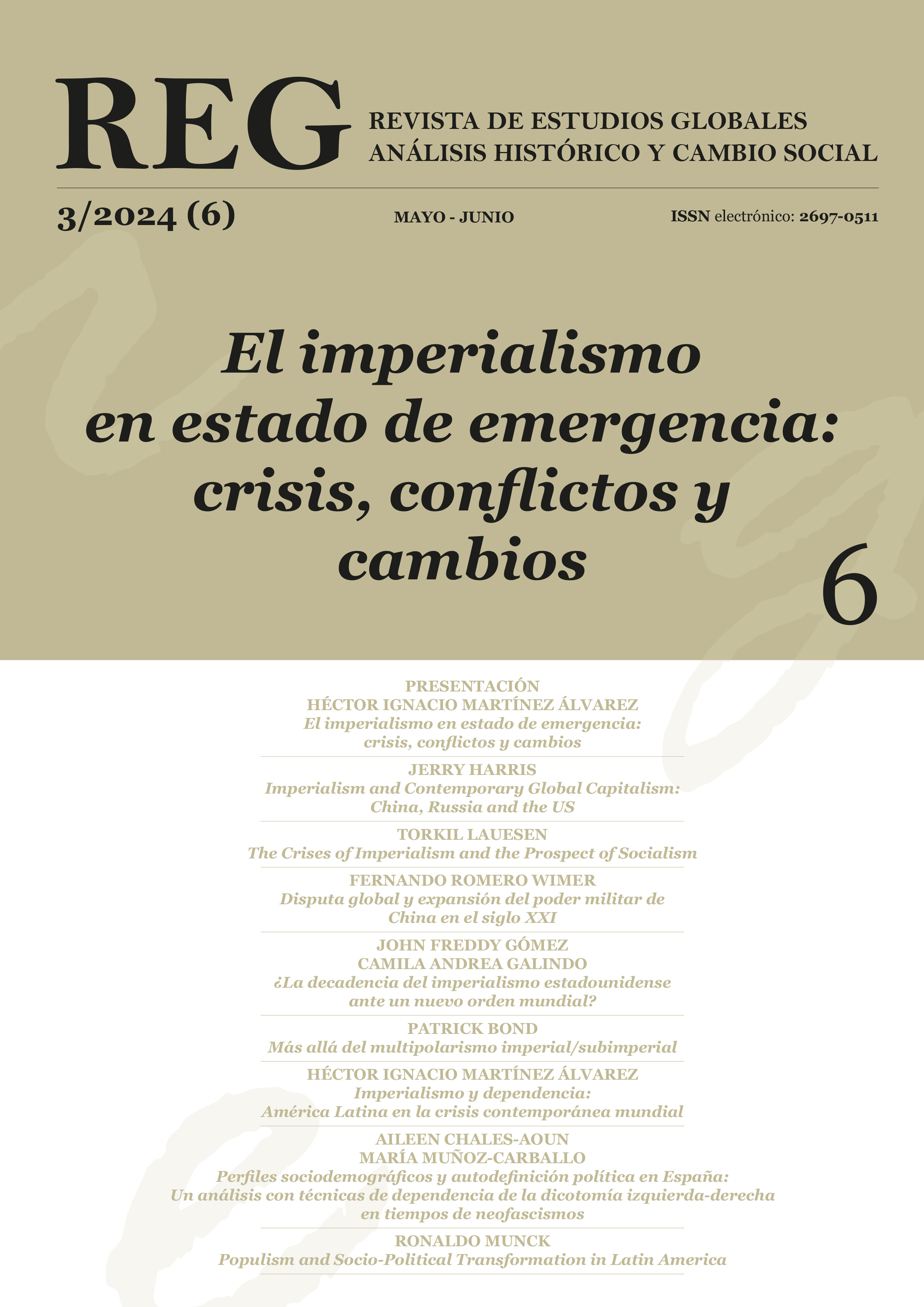Sociodemographic profiles and political self-definition in Spain:
An analysis with dependency techniques of the left-right dichotomy in times of neo-fascism
Abstract
In recent years, a growth of the right has been perceived in various parts of the world, and Spain has been no exception. To analyze this phenomenon, and without the intention of polarization, it is necessary to look back and compare the ideological positions of the Spanish electorate forty years after the beginning of the Spanish democratic period (1983-2023). In this sense, this research aimed to determine the sociodemographic profiles of Spaniards according to their political self-location in the left-right dimension. For this, the database of the latest CIS barometer of March 2023 was used to perform a logistic regression analysis and a discriminant analysis. It was found that the current panorama of the left-right dichotomy is very similar to the first democratic period (1983-2011). The sociodemographic variables that would predict self-assignment of left or right would be, in order of decreasing importance, the person's religion, social class, sex, and age. In conclusion, although the perception of a right-wing social hegemony in Spain is demystified, it is important to always carry out these historical-political analyzes from a longitudinal, contextual and methodologically responsible approach to avoid falling into polarizing sensationalism.
Downloads
Metrics
-
Abstract314
-
pdf (Español (España))116
References
Brussino, S., Imhoff, D., Paz-García, A. P., y Dreizik, M. (2017). El análisis psico-político de la ideología política. En Brussino, S. (Coord.), Políticamente, contribuciones desde la psicología política en Argentina (pp. 73-104). CONICET.
Bueno, G. (2008). El mito de la derecha: ¿Qué significa ser de derechas en la España actual?. Temas de hoy.
Cea M. A. (2004). Análisis multivariable. Teoría y práctica en la investigación social. Síntesis.
Cea, M. A. (2004b). Métodos de encuesta: Teoría y práctica, errores y mejora. Síntesis.
CIS (2023). Cuestiones de actualidad (marzo 2023). https://www.cis.es/cis/export/sites/default/-Archivos/Marginales/3400_3419/3401/cues3401.pdf
CIS (2023b). Ficha Técnica. Estudio CIS Nº3401. https://www.cis.es/cis/export/sites/default/-Archivos/Marginales/3400_3419/3401/FT3401.pdf
Cordero, G. y Martin, I. (2011). Quiénes son y cómo votan los españoles de izquierda. Los Libros de la Catarata-Fundación Alternativas.
De Andrés, J. (2002). El golpe de estado de la transición, las causas, actores, desarrollo y consecuencias del 23-F. En C. Navajas (Coord.), Actas del III Simposio de Historia Actual (pp. 463-482). Instituto de Estudios Riojanos.
Dogan, M. (2021). La ciencia política y las otras ciencias sociales. En Goodin, R. y Klingemann, Hans-Dieter (Eds.). Nuevo Manual de Ciencia Política. Ediciones Istmo.
Fernandez, A. y Rodriguez, J. (1996). Fascismo y Neofascismo. Arco Libros.
Gil, J., García, E. y Rodriguez, G. (2001). Análisis discriminante. La Muralla.
Glotz, P. (1992). Die Linke nach dem Sieg des Westens. Verlags-Anstalt, Stuttgart.
Gonzalez-Ferrer, L. y Queirolo-Velasco, R. (2013). Izquierda y derecha: formas de definirlas, el caso latinoamericano y sus implicaciones. América Latina Hoy, 65, 79-105. https://doi.org/10.14201/alh20136579105
Hosmer, D. y Lemeshow (1989). Applied logistic regression. John Wiley & Sons.
Jovell, A. (2006). Análisis de regresión logística. Cuadernos Metodológicos Nº15. Centro de Investigaciones Sociológicas.
Laponce, J. (1981). Left or right: The tipology of Political Perceptions. University de Toronto Press.
Lau, R., y Redlawsk, D. P. (2006). How voters decide: Information processing in election campaigns. Cambridge University Press.
Mair, P.(2007). Left—right Orientations»: En Dalton, R. y Klingemann, H. (Eds.), The Oxford Handbook of Political Behavior. Oxford University.
McCoy, J., Rahman, T., y Somer, M. (2018). Polarization and the global crisis of democracy: Common patterns, dynamics, and pernicious consequences for democratic policies. American Behavioral Scientist, 62(1), 16-42. https://doi.org/10.1177/0002764218759576
McFadden, D. (1974). Conditional logit analysis of qualitative choice behavior. En Zarembka, P. (Eds.), Frontiers in econometrics. Academic Press.
Medina, L. (2015). Izquierda y derecha en España: un estudio longitudinal y comparado. Centro de Investigaciones Sociológicas.
Mulaik, S. (1998). Parsimony and Model Evaluation. The Journal of Experimental Education, 66(3), 266-273. https://www.jstor.org/stable/20152565
Navas, A. (2014). Izquierda y Derecha: ¿una tipología válida para un mundo globalizado?. Revista de Comunicación, 13, 163-176. https://revistadecomunicacion.com/article/view/2724/2233
Rey, P. (2004). Nota metodológica sobre los indicadores del barómetro del CIS. Revista Española de Investigaciones Sociológicas, 108(4), 151-178. http://www.redalyc.org/articulo.oa?id=99717669006
Sani, G. y Montero, J. (1986). El espectro político: izquierda, derecha y centro. En J. Linz y J. Montero (Eds.), Crisis y cambio: Electores y partidos en la España de los años ochenta. Centro de Estudios Constitucionales.
Sartori, G. (1976). Parties and Party Systems: A Framework for Analysis. Cambridge University Press.
Silva, L. y Barroso, I. (2004). Regresión logística. La Muralla.
Valera-Ordaz, L. y Doménech-Beltrán, J. (2020). Perfil sociodemográfico y actitudes políticas de los grupos a favor y en contra de limitar la libre circulación de información durante la pandemia. Profesional de la información, 29(6), e290616. https://doi.org/10.3145/epi.2020.nov.16
Thurstone, L. (1947). Multiple factor analysis. University of Chicago Press.
Toscano, E. (2021). Fascismo, neofascismo y la crisis de la democracia. Encrucijadas, 21(2), e2105. https://recyt.fecyt.es/index.php/encrucijadas/article/view/92661
Zechmeister, E. y Corral, M. (2012) Individual and Contextual Constraints on Ideological Labels in Latin America. Comparative Political Studies, 46(6), 675-701. https://doi.org/10.1177/0010414012463880
Copyright (c) 2024 Revista de Estudios Globales. Análisis Histórico y Cambio Social

This work is licensed under a Creative Commons Attribution-NonCommercial-NoDerivatives 4.0 International License.










